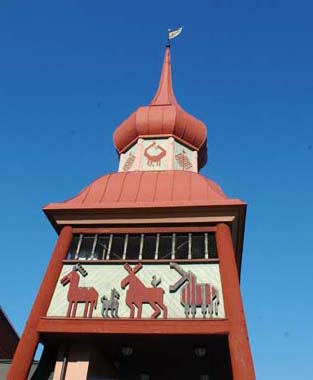|
Härjulf Hornbrytare
Härjulf Hornbrytra was a Norwegian believed to have lived in the 8th century. He was the main character in "Härjulfssagan", which tells how Härjedalen got its first permanent settlement. The name Härjulf is inextricably linked with Härjedalen Härjedalen () is a historical province (''landskap'') in the centre of Sweden. It borders the Norwegian county of Trøndelag, as well as the provinces of Dalarna, Hälsingland, Medelpad and Jämtland. The province originally belonged to Norway, ..., and it is also claimed that the landscape is named after this burnt Viking. References Written sources * Härjulf Hornbrytare in '' Norrländsk uppslagsbok'', Band 2, 1994 External linksLillhärdal – historia [...More Info...] [...Related Items...] OR: [Wikipedia] [Google] [Baidu] |
8th Century
The 8th century is the period from 701 (represented by the Roman numerals DCCI) through 800 (DCCC) in accordance with the Julian Calendar. In the historiography of Europe the phrase the long 8th century is sometimes used to refer to the period of circa AD 660–820. The coast of North Africa and the Iberian Peninsula quickly came under Islamic Arab domination. The westward expansion of the Umayyad Empire was famously halted at the siege of Constantinople by the Byzantine Empire and the Battle of Tours by the Franks. The tide of Arab conquest came to an end in the middle of the 8th century.Roberts, J., '' History of the World'', Penguin, 1994. In Europe, late in the century, the Vikings, seafaring peoples from Scandinavia, begin raiding the coasts of Europe and the Mediterranean, and go on to found several important kingdoms. In Asia, the Pala Empire is founded in Bengal. The Tang dynasty reaches its pinnacle under Chinese Emperor Xuanzong. The Nara period begins in ... [...More Info...] [...Related Items...] OR: [Wikipedia] [Google] [Baidu] |
Härjedalen
Härjedalen () is a historical province (''landskap'') in the centre of Sweden. It borders the Norwegian county of Trøndelag, as well as the provinces of Dalarna, Hälsingland, Medelpad and Jämtland. The province originally belonged to Norway, but was ceded to Sweden in the Second Treaty of Brömsebro in 1645. The province forms the bulk of Härjedalen Municipality of which the village of Sveg is the seat. Etymology The name ''Härjedalen'', from Old West Norse , literally means the "Valley of the Härje river". A Latinized transliteration is Herdalia although that name is today hardly encountered in the English today. More prominent are derivations such as ''Herjedalen'' or ''Haerjedalen''. The more prosaic explanation of the name is that the word ''her'' or ''har'' means only "mound of stones" and refers to stones in the river . History Härjedalen and Jämtland were provinces of Denmark-Norway until the mid-17th century. After the Treaty of Brömsebro in 1645, H� ... [...More Info...] [...Related Items...] OR: [Wikipedia] [Google] [Baidu] |
Kettil Jamte
{{given name ...
Kettil is a given name. Notable people with the name include: *Kettil Karlsson (Vasa) (1433–1465), Swedish clergyman and regent of Sweden under the Kalmar Union from February 1464 to August 1465 * Kettil Runske, according to Olaus Magnus's Historia de Gentibus Septentrionalibus (1555), the man who brought runes to humankind *Kettil Trout, North Norwegian chieftain from Ramsta (Hrafnista) in Hålogaland, from Icelandic saga '' Kettil Hoeng'' or ''Ketils saga hœngs'' See also *Kjetil Kjetil is a Norwegian masculine given name. It may refer to: * Kjetil Aleksander Lie (born 1980), Norwegian chess player, Norway's eighth International Grandmaster *Kjetil André Aamodt (born 1971), Norwegian former alpine ski racer * Kjetil Bang- ... [...More Info...] [...Related Items...] OR: [Wikipedia] [Google] [Baidu] |
Jamtli
Jamtli is the name of the regional open air museum of Jämtland and Härjedalen in Östersund, Sweden. It consists of an open-air museum with historical buildings, and an indoor museum with both permanent and temporary exhibitions. “Jamtli” literally means “hillside of Jämtland” in the local dialect. Since the 1980s, the museum has been working with living history in a project entitled ''Jamtli Historyland''. This venture has contributed to make the museum one of the most popular tourist attractions in the region. History Jamtli has its roots in the antiquarian association of Jämtland, established in 1886. After years of preparations led by the County Governor’s wife :sv:Ellen Widén, the open-air museum was inaugurated in 1912, and :sv:Eric Festin was appointed as its first director. In the early years, the museum focused on collecting and exhibiting historical buildings and items, but also organized courses in folk dance, handicraft and music. The aim was to keep ... [...More Info...] [...Related Items...] OR: [Wikipedia] [Google] [Baidu] |
8th-century European People
The 8th century is the period from 701 (represented by the Roman numerals DCCI) through 800 (DCCC) in accordance with the Julian Calendar. In the historiography of Europe the phrase the long 8th century is sometimes used to refer to the period of circa AD 660–820. The coast of North Africa and the Iberian Peninsula quickly came under Islamic Arab domination. The westward expansion of the Umayyad Caliphate, Umayyad Empire was famously halted at the Siege of Constantinople (718), siege of Constantinople by the Byzantine Empire and the Battle of Tours by the Franks. The tide of Arab conquest came to an end in the middle of the 8th century.Roberts, J., ''History of the World (book), History of the World'', Penguin, 1994. In Europe, late in the century, the Vikings, seafaring peoples from Scandinavia, begin raiding the coasts of Europe and the Mediterranean, and go on to found several important Monarchy, kingdoms. In Asia, the Pala Empire is founded in Bengal. The Tang dynasty ... [...More Info...] [...Related Items...] OR: [Wikipedia] [Google] [Baidu] |


